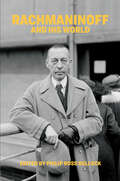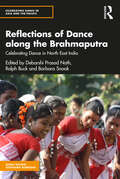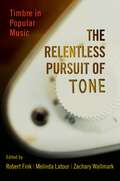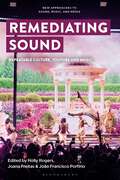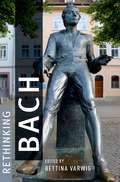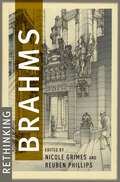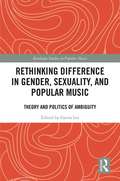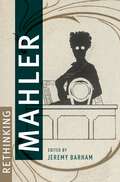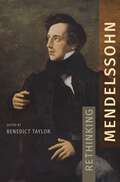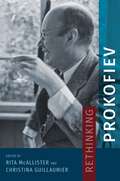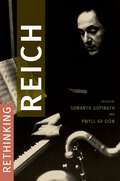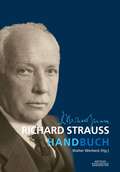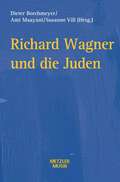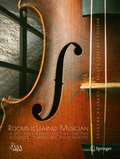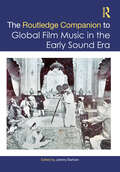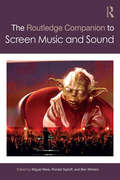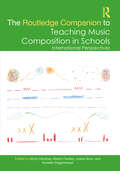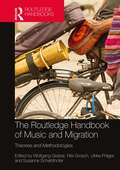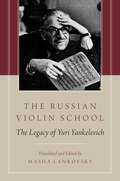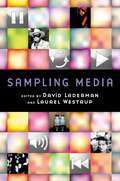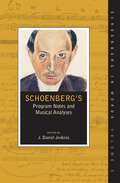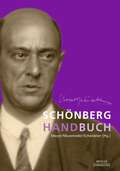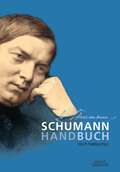- Table View
- List View
Rachmaninoff and His World (Bard Music Festival)
A biography of composer Sergei Rachmaninoff, published in collaboration with the Bard Music Festival. One of the most popular classical composers of all time, Sergei Rachmaninoff (1873–1943) has often been dismissed by critics as a conservative, nostalgic holdover of the nineteenth century and a composer fundamentally hostile to musical modernism. The original essays collected here show how he was more responsive to aspects of contemporary musical life than is often thought, and how his deeply felt sense of Russianness coexisted with an appreciation of American and European culture. In particular, the essays document his involvement with intellectual and artistic circles in prerevolutionary Moscow and how the form of modernity they promoted shaped his early output. This volume represents one of the first serious explorations of Rachmaninoff’s successful career as a composer, pianist, and conductor, first in late Imperial Russia, and then after emigration in both the United States and interwar Europe. Shedding light on some unfamiliar works, especially his three operas and his many songs, the book also includes a substantial number of new documents illustrating Rachmaninoff’s celebrity status in America.
Reflections of Dance along the Brahmaputra: Celebrating Dance in North East India (Celebrating Dance in Asia and the Pacific)
This volume brings a critical lens to dance and culture within North East India. Through case studies, first-hand accounts, and interviews, it explores unique folk dances of Indigenous communities of North East India that reflect diverse journeys, lifestyles, and connections within their ethnic groups, marking almost every ritual and festival. Dance for people of North East India, as elsewhere, is also a way of declaring, establishing, celebrating, and asserting humans' relationship with nature. The book draws attention to the origins and special circumstances of dances from North East India. It discusses a range of important folk-dance forms alongside classical dance forms in North East India, with a focus on Sattriya dance. The chapters examine how these dance forms play an important role in the region’s socio-cultural, economic, and political life, intertwining religion and the arts through music, dance, and drama. Further, they also explore how folk dance cultures in North East India have never been relegated to the background, never considered secondary, aesthetically, or otherwise, but have become expressions of political and cultural identity. An evocative work, this volume will be of interest to students and researchers of pedagogy, choreography, community dance practice, theatre and performance studies, social and cultural studies, aesthetics, interdisciplinary arts, and more. It will be an invaluable resource for artists and practitioners working in dance schools and communities.
The Relentless Pursuit of Tone: Timbre in Popular Music
The Relentless Pursuit of Tone: Timbre in Popular Music assembles a broad spectrum of contemporary perspectives on how "sound" functions in an equally wide array of popular music. Ranging from the twang of country banjoes and the sheen of hip-hop strings to the crunch of amplified guitars and the thump of subwoofers on the dance floor, this volume bridges the gap between timbre, our name for the purely acoustic characteristics of sound waves, and tone, an emergent musical construct that straddles the borderline between the perceptual and the political. Essays engage with the entire history of popular music as recorded sound, from the 1930s to the present day, under four large categories. "Genre" asks how sonic signatures define musical identities and publics; "Voice" considers the most naturalized musical instrument, the human voice, as racial and gendered signifier, as property or likeness, and as raw material for algorithmic perfection through software; "Instrument" tells stories of the way some iconic pop music machines-guitars, strings, synthesizers-got (or lost) their distinctive sounds; "Production" then puts it all together, asking structural questions about what happens in a recording studio, what is produced (sonic cartoons? rockist authenticity? empty space?) and what it all might mean.
Remediating Sound: Repeatable Culture, YouTube and Music (New Approaches to Sound, Music, and Media)
Remediating Sound studies the phenomena of remixing, mashup and recomposition: forms of reuse and sampling that have come to characterise much of YouTube's audiovisual content. Through collaborative composition, collage and cover songs to reaction videos and political activism , users from diverse backgrounds have embraced the democratised space of YouTube to open up new and innovative forms of sonic creativity and push the boundaries of audiovisual possibilities. Observing the reciprocal flow of influence that runs between various online platforms, 12 chapters position YouTube as a central hub for the exploration of digital sound, music and the moving image. With special focus on aspects of networked creativity that remain overlooked in contemporary scholarship, including library music, memetic media, artificial intelligence, the sonic arts and music fandom, this volume offers interdisciplinary insight into contemporary audiovisual culture.
Rethinking Bach
Johann Sebastian Bach has loomed large in the imagination of scholars, performers, and audiences since the late nineteenth century.This new book, edited by veteran Bach scholar Bettina Varwig, gathers a diverse group of leading and emerging Bach researchers as well as a number of contributors from beyond the core of Bach studies. The book's fourteen chapters engage in active 'rethinking' of different topics connected with Bach; the iconic name which broadly encompasses the historical individual, the sounds and afterlives of his music, as well as all that those four letters came to stand for in the later popular and scholarly imagination. In turn, challenging the fundamental assumptions about the nineteenth-century Bach revival, the rise of the modern work concept, Bach's music as a code, and about editions of his music as monuments. Collectively, these contributions thus take apart, scrutinize, dust off and reassemble some of our most cherished narratives and deeply held beliefs about Bach and his music. In doing so, they open multiple pathways towards exciting future modesof engagement with the composer and his legacy.
Rethinking Brahms
As one of the most significant and widely performed composers of the nineteenth century, Brahms continues to command our attention. Rethinking Brahms counterbalances prevailing scholarly assumptions that position him as a conservative composer (whether musically or politically) with a wide-ranging exploration and re-evaluation of his significance today. Drawing on German- and English-language scholarship, it deploys original approaches to his music and pursues innovative methodologies to interrogate the historical, cultural, and artistic contexts of his creativity. Empowered by recent theoretical work on form and tonality, it offers fresh analytical insights into his music, including a number of corpus studies that interrogate the relationships between Brahms and other composers, past and present. The book brings into sharp focus the productive tension that exists between the perceived fixedness of musical texts and the ephemerality of performance by considering how historical and modern performers shape established understandings of Brahms and his music. Rethinking Brahms invites the reader to hear familiar pieces anew as they are refracted through historical, artistic, and philosophical prisms. Bringing us up to the present day, it also gives sustained attention to the resounding impact of Brahms's compositions on new music by exploring works by recent composers who have engaged deeply with his oeuvre. Combining awareness of overarching contexts with perceptive insights into Brahms's music, this book enlivens our understanding of Brahms, providing a dynamic, multifaceted, complex, and invigoratingly fresh portrait of the composer.
Rethinking Difference in Gender, Sexuality, and Popular Music: Theory and Politics of Ambiguity (Routledge Studies in Popular Music)
In studies of gender and sexuality in popular music, the concept of difference is often a crucial analytic used to detect social agency; however, the alternative analytic of ambiguity has never been systematically examined. While difference from heterosexual norms is taken to be the multivalent sign of resistance, oppression, and self-invention, it can lead to inflated claims of the degree and power of difference. This book offers critically-oriented case studies that examine the theory and politics of ambiguity. Ambiguity means that there are both positive and negative implications in any gender and sexuality practices, both sameness and difference from heteronormativity, and unfixed possibility in the diverse nature of discourse and practice (rather than just "difference" among fixed multiplicities). Contributors present a diverse array of approaches through music, sound, psyche, body, dance, performance, race, ethnicity, power, discourse, and history. A wide variety of popular music genres are broached, including gay circuit remixes, punk rock, Goth music, cross-dress performance, billboard 100 songs, global pop, and nineteenth-century minstrelsy. The authors examine the ambiguities of performance and reception, and address the vexed question of whether it is possible for genuinely new forms of gender and sexuality to emerge musically. This book makes a distinctive contribution to studies of gender and sexuality in popular music, and will be of interest to fields including Popular Music Studies, Musicology/Ethnomusicology, Cultural Studies, Queer Studies, and Media Studies.
Rethinking Mahler
As one of the most popular classical composers in the performance repertoire of professional and amateur orchestras and choirs across the world, Gustav Mahler continues to generate significant interest, and the global appetite for his music, and for discussions of it, remains large. Editor Jeremy Barham brings together leading and emerging scholars in the field to explore Mahler's relationship with music, media, and ideas past and present, addressing issues in structural analysis, performance, genres of stage, screen and literature, cultural movements, aesthetics, history/historiography and temporal experience. Rethinking Mahler counterbalances prevailing scholarly assumptions and preferences that configure Mahler as proto-modernist, with hitherto neglected consideration of his debt to, and his re-imagining of, the legacies of his own historical past. Over the course of 17 chapters drawing from a variety of disciplinary perspectives, the book pursues ideas of nostalgia, historicism and 'pastness' in relation to an emergent modernity and subsequent musical-cultural developments, yielding a wide-ranging exploration and re-evaluation of Mahler's works, their historical reception and understanding, and their resounding impact within diverse cultural contexts. Rethinking Mahler will be an essential resource for scholars and students of Mahler and late Romantic era music more generally, and will also find an audience among the many devotees of Mahler's music.
Rethinking Mendelssohn
As one of the foremost composers, conductors, and pianists of the nineteenth century, Felix Mendelssohn played a fundamental role in the shaping of modern musical tastes through his contributions to the early music revival and the formation of the Austro-German musical canon. His career allows for a remarkable meeting point for critical engagement with a host of crucial issues in the last two centuries of music history, including the relation between musical meaning and social function, programmatic and absolute music, notions of classicism and Romanticism, modernism and historicism. It also serves as a pertinent case-study of the roles political ideology, racism, and musical ignorance may play in creating and perpetuating a composer's posthumous reception. Fittingly, Rethinking Mendelssohn focuses on critical engagement with the composer's music and aesthetics, and on the interpretation of his works in relation to contemporaneous culture. Building on the renaissance in Mendelssohn scholarship of the last two decades, Rethinking Mendelssohn sets a fresh and exciting tone for research on the composer. Opening new ways of understanding Mendelssohn and setting the future direction of Mendelssohn studies, the contributing scholars pay particular attention to Mendelssohn's contested views on the relationship between art and religion, analysis of Mendelssohn's instrumental music in the wake of recent controversies in Formenlehre, and the burgeoning interest in his previously neglected contribution to the German song.
Rethinking Prokofiev
Among major 20th-century composers whose music is poorly understood, Sergei Prokofiev stands out conspicuously. The turbulent times in which Prokofiev lived and the chronology of his travels-he left Russia in the wake of Revolution, and returned at the height of the Stalinist purges-have caused unusually polarized appraisals of his music. While individual, distinctive, and instantly recognizable, Prokofiev's music was also idiosyncratically tonal in an age when tonality was largely passé. Prokofiev's output therefore has been largely elusive and difficult to assess against contemporary trends. More than sixty years after the composer's death, editors Rita McAllister and Christina Guillaumier offer Rethinking Prokofiev as an assessment that redresses this enigmatic composer's legacy. Often more political than artistic, these appraisals have depended not only upon the date of publication but also the geographical location of the writer. Commissioned from some of the most distinguished and rising scholars in the field, this collection highlights the background and context of Prokofiev's work. Contributors delve into the composer's relationship to nineteenth-century Russian traditions, Silver-Age and Symbolist composers and poets, the culture of Paris in the 1920s and '30s, and to his later Soviet colleagues and younger contemporaries. They also investigate his reception in the West, his return to Russia, and the effect of his music on contemporary popular culture. Still, the main focus of the book is on the music itself: his early, experimental piano and vocal works, as well as his piano concertos, operas, film scores, early ballets, and late symphonies. Through an empirical examination of his characteristic harmonies, melodies, cadences, and musical gestures-and through an analysis of the newly uncovered contents of his sketch-books-contributors reveal much of what makes Prokofiev an idiosyncratic genius and his music intriguing, often dramatic, and almost always beguiling.
Rethinking Reich
Described by music critic Alex Ross as "the most original musical thinker of our time" and having received innumerable accolades in a career spanning over fifty years, composer Steve Reich is considered by many to be America's greatest contemporary composer. His music, however, remains largely underresearched. Rethinking Reich redresses this imbalance, providing a space for prominent and emerging scholars to reassess the composer's contribution to music in the twentieth century. Featuring fourteen tightly focused and multifarious essays on various aspects of Reich's work--ranging from analytical, aesthetic, and archival studies to sociocultural, philosophical, and ethnomusicological reflections--this edited volume reveals new insights, including those enabled by access to the growing Steve Reich Collection at the Paul Sacher Foundation archive, the premier institution for primary research on twentieth-century and contemporary classical music. This volume takes on the timely task of challenging the hegemony of Reich's own articulate and convincing discourses on his music, as found in his Writings on Music (OUP, 2002), and breaks new ground in the broader field of minimalism studies.
Richard Strauss-Handbuch
Zum 150. Geburtstag von Richard Strauss. Er zählt zu den bedeutendsten Komponisten vor und nach 1900. Tondichtungen wie Till Eulenspiegel , aber auch Opern wie der Rosenkavalier werden heute vielerorts weiterhin gespielt. Zum Jubiläumsjahr bietet das Handbuch ein differenziertes Bild des Komponisten, macht mit der aktuellen Forschung bekannt und lädt zugleich dazu ein, alle Seiten von Richard Strauss kennenzulernen: auch den Komponisten von Liedern, Kammer- und Chormusik; den Dirigenten, den Musikfunktionär, den Geschäftsmann und den Privatmann.
Richard Wagner und die Juden
Wagner und die Juden. Sind Wagners musikalischen Werke frei von antisemitischen Tendenzen? Dieser Frage wird in dem Band biographisch, historisch, ideologiegeschichtlich, politologisch und musikalisch auf umfassende Weise nachgegangen. "Gewiss, es ist viel "Hitler" in Wagner." Thomas Mann
Rooms for the Learned Musician: A 20-Year Retrospective on the Acoustics of Music Education Facilities
This beautifully illustrated volume takes the reader on a wide-ranging tour through music education facilities designed during the past 20 years, with a particular emphasis on the acoustical and architectural design of the locations. The book opens with a series of essays from key design team members, including an acoustical consultant, architect, audio/video systems consultant, and theatre consultant. The main body of the work consists of a rich array of contributions from acoustical consulting firms and music education facility designers from across the world on their recent innovative works in the area of music education facility acoustics. Each entry includes high-resolution photos and renderings, scientific data, and evocative descriptions of the music education facilities. Filled with beautiful photography and fascinating modern design, this book is a must-read for anyone interested in music education architecture, acoustical design, or musical performance. “This new publication on design of music education facilities is highly welcomed. Not only does it present many acoustically interesting projects, it also gives an up-to-date introduction to the scientific knowledge and design practice in this field. The book also helps the reader to understand why it is so important to ensure good acoustic conditions in music education facilities: to nourish students at all levels to achieve their goals as musicians.” - Anders Chr. Gade, Ph.D., senior consultant at Gade & Mortensen Akustik and author of Acoustics in Halls for Speech and Music (chapter in Springer Handbook of Acoustics) “This book ensures the reader will see the full vocabulary of elemental solutions to broad challenges. The expected concert halls, rehearsal spaces, and practice rooms are joined by newer, essential components: recording studios, control rooms, vocal booths, beat labs, and more. This media-rich publication enables detailed study while motivating big picture, interdisciplinary thinking. This new book curates and beautifully structures a deep store of outstanding architectural achievements that are sure to kindle the creation of future successful music education facilities.” - Alex U. Case, Associate Professor of Sound Recording Technology at the University of Massachusetts Lowell and author of Sound FX – Unlocking the Creative Potential of Recording Studio Effects “This book is a wonderful collection of music education facilities. The narratives and images provide a wealth of information for the casual reader, student in acoustics, architect, owner/educator, and acoustician. Primary schools through universities are not often studied and reviewed. Finding a thorough collection of these space types is rare. This book is recommended for anyone who is studying, designing, or enjoys reading about music education facilities.” - Jason Duty, P.E., Vice President at Charles M. Salter Associates, Inc.
The Routledge Companion to Global Film Music in the Early Sound Era (Routledge Music Companions)
In a major expansion of the conversation on music and film history, The Routledge Companion to Global Film Music in the Early Sound Era draws together a wide-ranging collection of scholarship on music in global cinema during the transition from silent to sound films (the late 1920s to the 1940s). Moving beyond the traditional focus on Hollywood, this Companion considers the vast range of cinema and music created in often-overlooked regions throughout the rest of the world, providing crucial global context to film music history. An extensive editorial Introduction and 50 chapters from an array of international experts connect the music and sound of these films to regional and transnational issues—culturally, historically, and aesthetically—across five parts: Western Europe and Scandinavia Central and Eastern Europe North Africa, The Middle East, Asia, and Australasia Latin America Soviet Russia Filling a major gap in the literature, The Routledge Companion to Global Film Music in the Early Sound Era offers an essential reference for scholars of music, film studies, and cultural history.
The Routledge Companion to Screen Music and Sound (Routledge Music Companions)
The Routledge Companion to Screen Music and Sound provides a detailed and comprehensive overview of screen music and sound studies, addressing the ways in which music and sound interact with forms of narrative media such as television, videogames, and film. The inclusive framework of "screen music and sound" allows readers to explore the intersections and connections between various types of media and music and sound, reflecting the current state of scholarship and the future of the field. A diverse range of international scholars have contributed an impressive set of forty-six chapters that move from foundational knowledge to cutting edge topics that highlight new key areas. The companion is thematically organized into five cohesive areas of study: Issues in the Study of Screen Music and Sound—discusses the essential topics of the discipline Historical Approaches—examines periods of historical change or transition Production and Process—focuses on issues of collaboration, institutional politics, and the impact of technology and industrial practices Cultural and Aesthetic Perspectives—contextualizes an aesthetic approach within a wider framework of cultural knowledge Analyses and Methodologies—explores potential methodologies for interrogating screen music and sound Covering a wide range of topic areas drawn from musicology, sound studies, and media studies, The Routledge Companion to Screen Music and Sound provides researchers and students with an effective overview of music’s role in narrative media, as well as new methodological and aesthetic insights.
The Routledge Companion to Teaching Music Composition in Schools: International Perspectives (Routledge Music Companions)
The Routledge Companion to Teaching Music Composition in Schools: International Perspectives offers a comprehensive overview of teaching composing from a wide range of countries around the world. Addressing the current state of composition pedagogy from primary to secondary school levels and beyond, the volume explores issues, including different curricular and extracurricular settings, cultural aspects of composing, aesthetics, musical creativity, the role of technology, and assessment. With contributors from over 30 countries, this volume encompasses theoretical, historical, empirical, and practical approaches and enables comparisons across different countries and regions. Chapters by experienced educators, composers, and researchers describe in depth the practices taking place in different international locations. Interspersed with these chapters, interludes by the volume editors contextualize and problematize the teaching and learning of composing music. The volume covers a range of contexts, including formal and informal, those where a national curriculum is mandated or where composing is a matter of choice, and a range of types, styles, and genres of musical learning and music-making. Providing a wide-ranging and detailed review of international approaches to incorporating music composition in teaching and learning, this volume will be a useful resource for teachers, music education researchers, graduate and undergraduate students, and all those working with children and young people in composing music.
The Routledge Handbook of Music and Migration: Theories and Methodologies (Routledge Music Handbooks)
The Routledge Handbook of Music and Migration: Theories and Methodologies is a progressive, transdisciplinary paradigm-shifting core text for music and migration studies. Conceptualized as a comprehensive methodological and theoretical guide, it foregrounds the mobile potentials of music and presents key arguments about why musical expressions matter in the discussion of migration politics. 24 international specialists in music and migration set methodological and theoretical standards for transdisciplinary collaborations in the field of migration studies, discussing 41 keywords, such as mobility, community, research ethics, human rights, and critical whiteness in the context of music and migration. The authors then apply these terms to 16 chapters, which deal with ethnomusicological, musicological, sociological, anthropological, geographical, pedagogical, political, economic, and media-related methodologies and theories which reflect and contest current discourses of migration. In their interdisciplinary focus, these chapters advance interrelations between music and migration as enabling factors for socio-cultural studies. Furthermore, the authors tackle crucial questions of agency, equality, and equity as well as the responsibilities and expectations of writers and artists when researching migration phenomena as innate human experience. As a result, this handbook provides scholars and students alike with relevant and applicable methodological and theoretical tools in addition to an extensive literature and research review for further research.
The Russian Violin School: The Legacy of Yuri Yankelevich
The Russian school of violin playing produced many of the twentieth century's leading violinists - from the famed disciples of Leopold Auer such as Jascha Heifetz, Nathan Milstein, and Mischa Elman to masters of the Soviet years such as David Oistrakh and Leonid Kogan. Though descendants of this school of playing are found today in every major orchestra and university, little is known about the pedagogical traditions of the Russian, and later Soviet, violin school. Following the revolution of 1917, the center of Russian violin playing and teaching shifted from St. Petersburg to Moscow, where violinists such as Lev Tseitlin, Konstantin Mostras, and Abraham Yampolsky established an influential pedagogical tradition. Founded on principles of scientific inquiry and physiology, this tradition became known as the Soviet Violin School, a component of the larger Russian Violin School. Yuri Yankelevich (1909 - 1973), a student and assistant of Abraham Yampolsky, was greatly influenced by the teachers of the Soviet School and in turn he became one of the most important pedagogues of his generation. Yankelevich taught at the Moscow Conservatory from 1936 to 1973 and produced a remarkable array of superb violinists, including forty prizewinners in international competitions. Extremely interested in the methodology of violin playing and teaching, Yankelevich contributed significant texts to the pedagogical literature. Despite its importance, Yankelevich's scholarly work has been little known outside of Russia. This book includes two original texts by Yankelevich: his essay on positioning the hands and arms and his extensive research into every detail of shifting positions. Additional essays and commentaries by those close to him examine further details of his pedagogy, including tone production, intonation, vibrato, fingerings and bowings, and his general approach to methodology and selecting repertoire. An invaluable resource for any professional violinist, Yankelevich's work reveals an extremely sophisticated approach to understanding the interconnectivity of all components in playing the violin and is complete with detailed practical suggestions and broad historical context.
Sampling Media
This book puts sampling studies on the academic map by focusing on sampling as a logic of exchange between audio-visual media. While some recent scholarship has addressed sampling primarily in relation to copyright, this book is a first: a critical study of sampling and remixing across audio-visual media. Of special interest here are works that bring together both audio and visual sampling: music that samples film and television; underground dance and multimedia scenes that rely on sampling; Internet "memes" that repurpose music videos, trailers and news broadcasts; films and videos that incorporate a wide range of sampling aesthetics; and other provocative variations. Comprised of four sections titled "roots," "scenes," "cinema" and "web" this collection digs deep into and across sampling practices that intervene in popular culture from unconventional or subversive perspectives. To this end, Sampling Media extends the conceptual boundaries of sampling by emphasizing its inter-medial dimensions, exploring the politics of sampling practice beyond copyright law, and examining its more marginal applications. It likewise puts into conversation compelling instances of sampling from a wide variety of historical and contemporary, global and local contexts.
Schoenberg's Program Notes and Musical Analyses (Schoenberg in Words)
In 1950, as Arnold Schoenberg anticipated the publication of a collection of 15 of his most important writings, Style and Idea, he was already at work on a second volume to be called Program Notes. Inspired by this idea, Schoenberg's Program Notes and Musical Analyses can boast the most comprehensive study of the composer's writings about his own music yet published. Schoenberg's insights emerge not only in traditional program notes, but also in letters, sketch materials, pre-concert talks, public lectures, contributions to scholarly journals, newspaper articles, interviews, pedagogical materials, and publicity fliers. The editions of the texts in this collection, based almost exclusively on Schoenberg's original manuscript sources, include many items appearing in print in English for the first time, as well as more familiar texts that preserve musical and textual information eliminated from previous editions. The book also reveals how Schoenberg, desirous to communicate with and educate an audience, took every advantage of changes in technology during his lifetime, utilizing print media, radio broadcasts, record jackets--and had he lived, television--for this purpose. In addition to four chapters in which Schoenberg illuminates 42 of his own compositions, the book begins with chapters on his development and influences, his thoughts about trends in modern music, and, in a nod to the importance of the radio in providing a venue for music analysis, a chapter about Schoenberg's radio broadcasts.
Schönberg-Handbuch
Arnold Schönberg war als Komponist und Künstlerpersönlichkeit gleichermaßen einflussreich und umstritten. Seine musikalischen Werke, seine Unterrichtstätigkeit und sein theoretisches Werk begründeten die „Neue Musik“ des 20. Jahrhunderts, seine Schriften – von der tagesaktuellen Polemik bis zur theologischen Reflexion – spiegeln die intellektuelle Entwicklung einer ganzen Epoche, seine bis heute kontrovers beurteilte Malerei ist ein faszinierender Nebenpfad des österreichischen Expressionismus. Zum 150. Geburtstag erscheint eine umfassende Bestandsaufnahme dieses Jahrhundertwerks – mit aktuellen Forschungsergebnissen, analytischen und essayistischen Beiträgen, ausführlicher Chronik und Werkregistern. Schönbergs „Lebenswelten“ – mit Schauplätzen u.a. in Wien, Berlin und Los Angeles – bieten den Hintergrund detaillierter Einzelbesprechungen der Kompositionen – von Verklärte Nacht bis zu Ein Überlebender aus Warschau. Im systematischen Durchgang kommen – neben den Schriften und bildnerischen Werken – grundlegende Fragen der musikalischen Poetik oder der Aufführungslehre zur Sprache. Ein eigener Hauptabschnitt gilt der epochalen Wirkung dieses Œuvres: von den Anfängen der Wiener Schule bis zur aktuellen Rezeption im 21. Jahrhundert.
Schönberg-Handbuch
Arnold Schönberg war als Komponist und Künstlerpersönlichkeit gleichermaßen einflussreich und umstritten. Seine musikalischen Werke, seine Unterrichtstätigkeit und sein theoretisches Werk begründeten die „Neue Musik“ des 20. Jahrhunderts, seine Schriften – von der tagesaktuellen Polemik bis zur theologischen Reflexion – spiegeln die intellektuelle Entwicklung einer ganzen Epoche, seine bis heute kontrovers beurteilte Malerei ist ein faszinierender Nebenpfad des österreichischen Expressionismus. Zum 150. Geburtstag erscheint eine umfassende Bestandsaufnahme dieses Jahrhundertwerks – mit aktuellen Forschungsergebnissen, analytischen und essayistischen Beiträgen, ausführlicher Chronik und Werkregistern. Schönbergs „Lebenswelten“ – mit Schauplätzen u.a. in Wien, Berlin und Los Angeles – bieten den Hintergrund detaillierter Einzelbesprechungen der Kompositionen – von Verklärte Nacht bis zu Ein Überlebender aus Warschau. Im systematischen Durchgang kommen – neben denSchriften und bildnerischen Werken – grundlegende Fragen der musikalischen Poetik oder der Aufführungslehre zur Sprache. Ein eigener Hauptabschnitt gilt der epochalen Wirkung dieses Œuvres: von den Anfängen der Wiener Schule bis zur aktuellen Rezeption im 21. Jahrhundert.
Schumann-Handbuch
Seine Musik hat ihn unsterblich gemacht. Doch wer war Robert Schumann? Als Komponisten und Virtuosen, Dichter und Journalisten, Freund und Ehemann lernt der Leser ihn kennen und findet Zugang zu seiner Literatur-, Musik- und Kunstanschauung. Im Mittelpunkt stehen Schumanns kompositorisches Lebenswerk und seine Kompositionsweise. Geordnet nach Gattungen liefert das Handbuch einen umfangreichen Überblick über sein gesamtes Werk. Schumanns Schaffen spiegelt sich auch in der Musik anderer Komponisten wider. In welchen Werken erkennt man seinen Einfluss? Wie haben Musikgeschichtsschreibung, Belletristik und Film Schumann gewürdigt? Die namhaften Autoren zeichnen ein neues, spannendes Bild.
